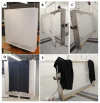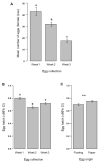Assessment of a Novel Adult Mass-Rearing Cage for Aedes albopictus (Skuse) and Anopheles arabiensis (Patton)
- PMID: 33202973
- PMCID: PMC7697024
- DOI: 10.3390/insects11110801
Assessment of a Novel Adult Mass-Rearing Cage for Aedes albopictus (Skuse) and Anopheles arabiensis (Patton)
Abstract
Successful implementation of the sterile insect technique (SIT) against Aedes albopictus and Anopheles arabiensis relies on a continuous supply of sterile males. To meet this requirement, optimization of the mass-rearing techniques is needed. This study, therefore, aims to assess a new mass-rearing cage (MRC) in terms of egg production efficiency and egg hatch rate (quality). In addition, adult survival was evaluated based on a cage adult-index for Ae. albopictus. Moreover, the cage's suitability for use in mass An. arabiensis egg production was compared to that of the FAO/IAEA Anopheles reference cage. In Ae. albopictus rearing, the new MRC produced 1,112,110 eggs per cage following six blood meals, with minimum loss of eggs in the egging water. Furthermore, the adult index gave a good proxy of daily mortality rates in Ae. albopictus. In An. arabiensis rearing, about 130,000 eggs per egg batch were collected both from the new and the reference MRC. These findings suggest that the new MRC prototype is efficient in terms of egg production and can be used for mass-rearing in SIT programs targeting Ae. albopictus as well as An. arabiensis. The adult index was also positively validated for the detection of unusual mortality rates in Ae. albopictus mass-rearing facilities. Overall, the new MRC has shown several advantages; however, further improvements are necessary to minimize escapes during the egg collection processes.
Keywords: adult index; dengue; egg production; genetic control; insect cage; malaria; plexiglass; sterile insect technique.
Conflict of interest statement
The authors declare no conflict of interest.
Figures




Similar articles
-
The Insect Pest Control Laboratory of the Joint FAO/IAEA Programme: Ten Years (2010-2020) of Research and Development, Achievements and Challenges in Support of the Sterile Insect Technique.Insects. 2021 Apr 13;12(4):346. doi: 10.3390/insects12040346. Insects. 2021. PMID: 33924539 Free PMC article. Review.
-
Optimization of mosquito egg production under mass rearing setting: effects of cage volume, blood meal source and adult population density for the malaria vector, Anopheles arabiensis.Malar J. 2017 Jan 24;16(1):41. doi: 10.1186/s12936-017-1685-3. Malar J. 2017. PMID: 28118825 Free PMC article.
-
Reducing the cost and assessing the performance of a novel adult mass-rearing cage for the dengue, chikungunya, yellow fever and Zika vector, Aedes aegypti (Linnaeus).PLoS Negl Trop Dis. 2019 Sep 25;13(9):e0007775. doi: 10.1371/journal.pntd.0007775. eCollection 2019 Sep. PLoS Negl Trop Dis. 2019. PMID: 31553724 Free PMC article.
-
Establishment of a medium-scale mosquito facility: tests on mass production cages for Aedes albopictus (Diptera: Culicidae).Parasit Vectors. 2018 Mar 19;11(1):189. doi: 10.1186/s13071-018-2750-7. Parasit Vectors. 2018. PMID: 29554945 Free PMC article.
-
The Possible Role of Microorganisms in Mosquito Mass Rearing.Insects. 2021 Jul 15;12(7):645. doi: 10.3390/insects12070645. Insects. 2021. PMID: 34357305 Free PMC article. Review.
Cited by
-
Requirements for market entry of gene drive-modified mosquitoes for control of vector-borne diseases: analogies to other biologic and biotechnology products.Front Bioeng Biotechnol. 2023 Jun 8;11:1205865. doi: 10.3389/fbioe.2023.1205865. eCollection 2023. Front Bioeng Biotechnol. 2023. PMID: 37362219 Free PMC article. Review.
-
The Insect Pest Control Laboratory of the Joint FAO/IAEA Programme: Ten Years (2010-2020) of Research and Development, Achievements and Challenges in Support of the Sterile Insect Technique.Insects. 2021 Apr 13;12(4):346. doi: 10.3390/insects12040346. Insects. 2021. PMID: 33924539 Free PMC article. Review.
-
Response of male adult Aedes mosquitoes to gamma radiation in different nitrogen environments.Front Bioeng Biotechnol. 2022 Sep 12;10:942654. doi: 10.3389/fbioe.2022.942654. eCollection 2022. Front Bioeng Biotechnol. 2022. PMID: 36172019 Free PMC article.
-
Sterile Insect Technique in an Integrated Vector Management Program against Tiger Mosquito Aedes albopictus in the Valencia Region (Spain): Operating Procedures and Quality Control Parameters.Insects. 2021 Mar 23;12(3):272. doi: 10.3390/insects12030272. Insects. 2021. PMID: 33807092 Free PMC article.
-
Strain Characterisation for Measuring Bioefficacy of ITNs Treated with Two Active Ingredients (Dual-AI ITNs): Developing a Robust Protocol by Building Consensus.Insects. 2022 May 6;13(5):434. doi: 10.3390/insects13050434. Insects. 2022. PMID: 35621770 Free PMC article.
References
-
- Hawley W.A. The biology of Aedes albopictus. J. Am. Mosq. Control Assoc. Suppl. 1988;1:1–39. - PubMed
-
- World-Malaria-Report-2019. [(accessed on 18 June 2020)]; Available online: https://www.who.int/publications-detail/world-malaria-report-2019.
LinkOut - more resources
Full Text Sources

